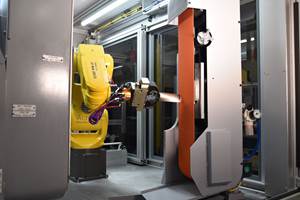AddUp, Dassault Systèmes Collaborate on Aerospace Digital Continuity Project
The companies are collaborating on the Aeroprint project, which aims to establish a certified additive manufacturing pilot line for aeronautics.
Share
AddUp has joined the Dassault Systèmes’ 3DExperience platform ecosystem as part of the Aeroprint project, which aims to establish a certified additive manufacturing (AM) pilot line for aeronautics. AddUp is a global metal AM OEM offering a series of industrial 3D metal printers utilizing both laser powder bed fusion (LPBF) and directed energy deposition (DED) technologies.
With the 3DExperience platform, Dassault Systèmes offers a dedicated set of applications for AM — from new material characterization, adapted design, build job preparation and simulation to shopfloor scheduling and execution monitoring. By working on a single platform, users can ensure digital continuity across the entire life cycle of parts production.
At the heart of this collaboration is Aeroprint, an R&D project driven by Dassault Aviation which is located in the French region of Auvergne-Rhône-Alpes. One of the expected deliverables is the establishment of a certified AM pilot line for aeronautics, an industry particularly sensitive to the benefits of this technology. Dedicated to accelerating the adoption of AM by the aeronautics industry, an industrial platform at the Argonay site is being set up. With such ambitions, the company says only perfectly integrated digital solutions can be considered. This is where AddUp and Dassault Systèmes’ work takes on its full meaning.
AddUp created a virtual twin of its FormUp 350 by using AddUp NTwin, a solution dedicated to FormUp interoperability, that enables 3DExperience platform users to seamlessly produce a job file, retrieve additional build information and run simulations. This Virtual Twin is available to 3DExperience platform users in the AddUp community hosted by Dassault Systèmes.
The company says interoperability is a strong expectation for industrial manufacturers that plan on taking AM to a daily large-scale level. It connects not only a single machine to a global industrial environment but also offers digital continuity and simplification for upstream production processes. In other words, it’s a key to efficiency, of which the Aeroprint project will be the first beneficiary.
The virtual twin of the FormUp 350 machine in the 3DExperience platform enables the production file to be created interactively. Thanks to this virtual twin, Dassault Aviation is able to ensure digital continuity from design to the manufacturing of the part in the 3DExperience platform.
Leaving the standard asynchronous workflow and its CAD-to-STL conversion, this synergy provides better traceability and flexibility over time. Users can access powerful 3DExperience platform features and applications, while creating strategies and generating trajectories within seconds using the AddUp Trajectory Generator. For perfect process mastery, trajectories are displayed directly in the Delmia application, before being sent to Simulia applications for process simulation.
The solution is available from the AddUp community, where they can also find information and use cases as well as ask AddUp and Dassault Systèmes members questions.
- Learn about AddUp adding Constellium’s Aheadd CP1 aluminum alloy to its material portfolio. The Aheadd CP1 aluminum alloy was developed by Constellium for the needs of additive manufacturing by laser powder bed fusion specifically for high-performance and lightweight applications.
- Read more about how AddUp’s FormUp 350 Evolution printer prints parts up to 1 meter tall. The FormUp 350 Evolution machine is designed to produce large metal parts with a high level of complexity and precision, which is an ability in high demand in the aeronautics, space, defense and energy sectors.
Related Content
Drones Take Flight with Metal and Polymer 3D Printed Parts: The Cool Parts Show Bonus
Drones produced by Cobra Aero now incorporate many 3D printed parts made through laser powder bed fusion and Multi Jet Fusion processes.
Read MoreHow Norsk Titanium Is Scaling Up AM Production — and Employment — in New York State
New opportunities for part production via the company’s forging-like additive process are coming from the aerospace industry as well as a different sector, the semiconductor industry.
Read MoreAdditive Manufacturing Is Subtractive, Too: How CNC Machining Integrates With AM (Includes Video)
For Keselowski Advanced Manufacturing, succeeding with laser powder bed fusion as a production process means developing a machine shop that is responsive to, and moves at the pacing of, metal 3D printing.
Read MoreAircraft Engine MRO: How Additive Manufacturing Plus Robotic Finishing Will Expand Capacity for Blade Repair
AM offers the chance to bring fast, automated processing to individualized, part-by-part restoration of turbomachinery. A cell developed by Acme Manufacturing and Optomec is able to automatically repair 85,000 unique aircraft engine blades per year.
Read MoreRead Next
At General Atomics, Do Unmanned Aerial Systems Reveal the Future of Aircraft Manufacturing?
The maker of the Predator and SkyGuardian remote aircraft can implement additive manufacturing more rapidly and widely than the makers of other types of planes. The role of 3D printing in current and future UAS components hints at how far AM can go to save cost and time in aircraft production and design.
Read MoreHybrid Additive Manufacturing Machine Tools Continue to Make Gains (Includes Video)
The hybrid machine tool is an idea that continues to advance. Two important developments of recent years expand the possibilities for this platform.
Read More3D Printing Brings Sustainability, Accessibility to Glass Manufacturing
Australian startup Maple Glass Printing has developed a process for extruding glass into artwork, lab implements and architectural elements. Along the way, the company has also found more efficient ways of recycling this material.
Read More






















